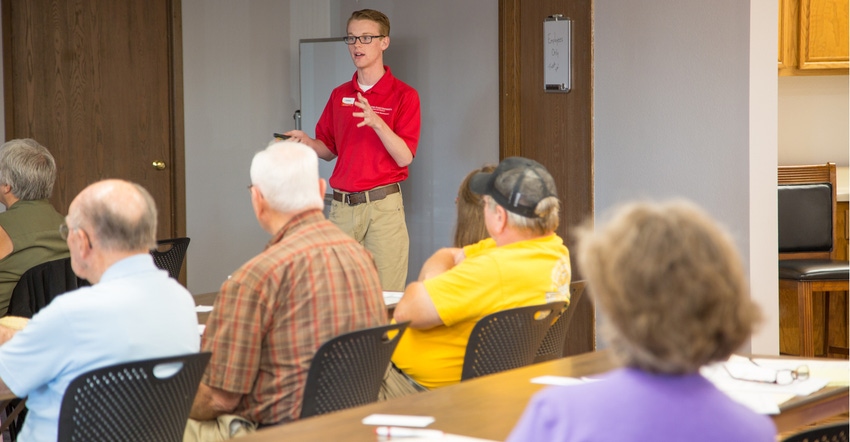September 18, 2017

By Cole Moody
With the increasing competition in today’s workforce, it is ever important to have quality experiences leading up to college graduation. This summer, I was fortunate enough to intern with Iowa State University Extension and Outreach as a farm management summer assistant in the Polk County office.
During my three months, I was able to able to learn by doing. Hopefully these efforts “added value” to the farm management educational program and the people it serves.
Let me outline the main components of my Extension internship in hopes of providing a more in-depth look at opportunities that others might explore:
• Central Iowa case study farm. In mid-May I began working on my major summer project — a case study farm for determining a fair 2017 cash rental rate. I used the Dallas County farm located just north of Adel, cash-rented since 2005 by the Des Moines Area Community College Agribusiness Program. The farm served as a real-world example, and DMACC provided data on actual crop production costs, the farm’s actual production history, local cash grain bids for harvest delivery and use of soil and water conservation practices. Additional data collected included yield, fertility and soil maps that helped examine crop productivity trends.
For the purpose of calculating a fair cash rental rate, I used the “Computing a Cropland Cash Rental Rate” decision tool, C2-20, found on the ISU Extension Ag Decision Maker website.
This Excel spreadsheet provides six different methods for determining a cash rental rate. Farmers, landowners and agribusiness personnel can use this decision tool to make cash rental rate calculations that more accurately reflect a fair cash rent.
The results were used to educate landowners, tenant operators and agribusiness professionals, and featured six different methods for calculating a fair cash rental rate. I presented this information initially at a Farmland Owners Workshop in Altoona in June and recorded a Vimeo video posted to the Polk County Extension Farm Management website.
• Grain bid comparison decision tool. My next project involved working with William Edwards, ISU emeritus professor of economics, to pilot a new decision tool (Excel spreadsheet) to be featured on the ISU Ag Decision Maker website. This decision tool allows for comparing a variety of “what if” scenarios for selling grain at various cash prices while considering your own transportation costs.
ISU Extension recently released the “Grain Bid Comparison Tool,” A3-41, found on the ISU Ag Decision Maker website.
I enjoyed looking at the difference in basis factors, as well as testing the tool before it was released for public use. Simply find up to five cash grain bids from various locations where you typically deliver corn or soybeans. Input these cash prices into the decision tool, along with your own estimates of operating costs and distance to haul the grain.
• Farmland leasing meetings. Annually, ISU Extension’s eight farm management field specialists conduct over 70 farmland leasing meetings statewide in late July and August. I presented the Central Iowa Case Study Farm at 10 different leasing meetings with over 300 participants in attendance. I promoted these meetings on a Des Moines television station, recorded a radio interview and wrote two articles that were published in Wallaces Farmer magazine.
• Activities along the way. Another important aspect of work I was doing this summer required me to be knowledgeable of current ag-related issues. I attended a cover crop field day near Lynnville in early June. There I learned about crop management practices, cover crop benefits and related trends in soil health and water quality.
In mid-June I attended a land auction in Dows, and observed the strategies and emotions connected to buying Iowa farmland. Before I went to the auction, I researched the farm and developed an estimate of what I thought the farm was worth. I ended up being $500 per tillable acre too high, but I learned a lot by studying farmland-related information and discussing with farmland real estate agents and prospective buyers.
With the hot, dry weather conditions in July, crop yield variability emerged as a major topic of discussion. I was able to sample seven different cornfields. Using ear and kernel counts, as well as measuring ear length, I developed a learning activity titled “Estimating Corn Yields,” which I demonstrated at the farmland leasing meetings.
Ultimately, I was extremely fortunate to have this summer internship opportunity and feel that it was a success for both me, as well as the ISU Extension farm management program. Being able to learn by doing, I gained hands-on experience that broadened my knowledge of not only the work ISU Extension and Outreach does, but of various facets of Iowa agriculture. Looking back on this summer, my experiences have helped me grow as a person and be better prepared for not just my next summer internship, but for a career in the agricultural industry.
I’m looking forward to using the skills I’ve learned as talking points for the ISU College of Agriculture and Life Sciences Career Day to be held Oct. 17. Anyone who is interested in finding out about internships and job opportunities offered by ag businesses and agencies is encouraged to attend.
Moody served as a farm management summer assistant working with Steve Johnson, farm management specialist with ISU Extension and Outreach.
You May Also Like




